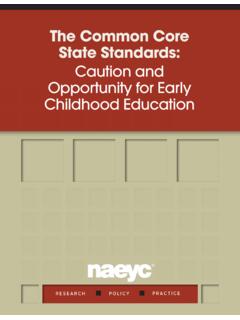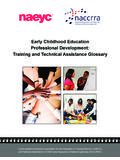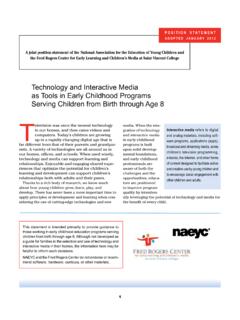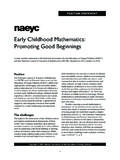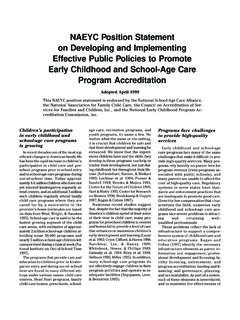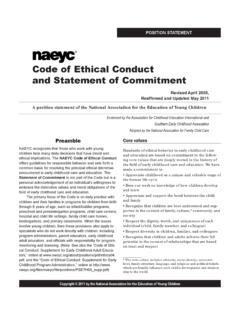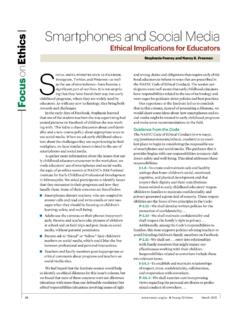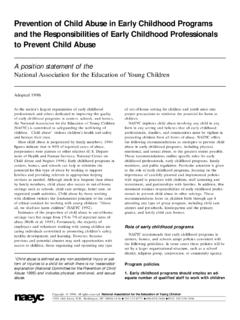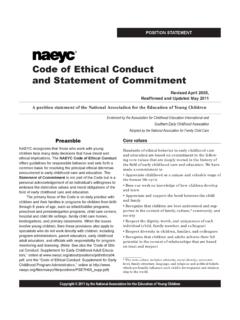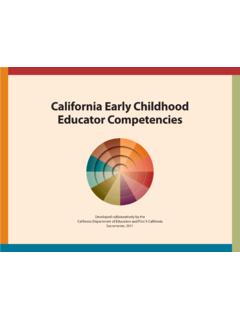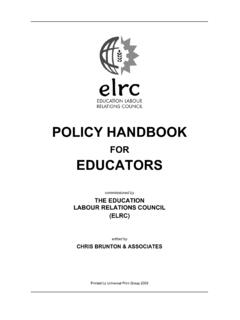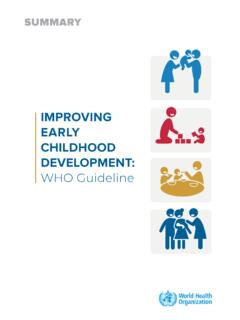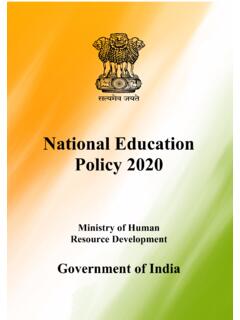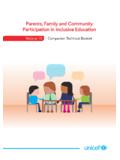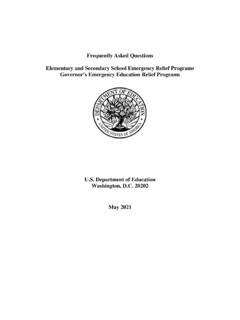Transcription of Endnotes - NAEYC
1 A POSITION STATEMENT OF THE NATIONAL ASSOCIATION FOR THE education OF YOUNG CHILDREN | 39 Endnotes1 American Federation of State, County and Municipal Employees; American Federation of Teachers; Associate Degree early childhood Teacher Educators; Child Care Aware of America; Council for Professional Recognition; Division for early childhood of the Council for Exceptional Children; early Care and education Consortium; National Association for Family Child Care; National Association for the education of Young Children; National Association of early childhood Teacher Educators; National Association of Elementary School Principals; National education Association; National Head Start Association; Service Employees International Union; & ZERO TO THREE.
2 2020. Unifying Framework for the early childhood education Profession. Washington, DC: NAEYC . NAEYC (National Association for the education of Young Children). 2020. Professional Standards and Competencies for early childhood Educators. Washington, DC: NAEYC . NAEYC . 2019. Advancing equity in early childhood education . Washington, DC: NAEYC . Cannon, J., Kilburn, M., Karoly, L., Mattox, T., Muchow, A., & Buenaventura, M. 2017. Investing early : Taking Stock of Outcomes and Economic Returns from early childhood Programs. Santa Monica, CA: RAND Corporation; Elango, S., Hojman, A., Garc a, , & Heckman, 2016.
3 early childhood education . In Means-Tested Transfer Programs in the United States II, ed. R. Moffitt, 235 297. Chicago, IL: University of Chicago Press; Ladd, H. F., Muschkin, C. G., & Dodge, K. A..2014. From Birth to School: early childhood Initiatives and Third-Grade Outcomes in North Carolina. Journal of Policy Analysis and Management 33 (1): 162 187. ; McCoy, , Yoshikawa, H., Ziol-Guest, , Duncan, , Schindler, , Magnuson, K., Yang, R., Koepp, A., & Shonkoff, 2017. Impacts of early childhood education on Medium- and Long-Term Educational Outcomes. Educational Researcher 46 (8): 474-487; Pre-Kindergarten Task Force.
4 2017. The Current State of Scientific Knowledge on Pre-Kindergarten Effects. Brookings & Duke Center for Child and Family Policy. ; NASEM (National Academies of Science, Engineering, and Medicine). 2018. How People Learn II: Learners, Contexts, and Cultures. Washington, DC: The National Academies Souto-Manning, Rabadi-Raol, A. 2018. (Re)Centering Quality in early childhood education : Toward Intersectional Justice for Minoritized Children. Review of Research in education 42 (1): 203 225. Cabrera, N. 2013. Minority Children and Their Families: A Positive Look. Being Black Is Not a Risk Factor: A Strengths-Based Look at the State of the Black Child.
5 4 7. Washington, DC: National Black Child Development P rez, & Saavedra, C. 2017. A Call for Onto-Epistemological Diversity in early childhood education and Care: Centering Global South Conceptualizations of childhood /s. Review of Research in education 41 (1): 1 Keller, H. 2018. Universality Claim of Attachment Theory: Children s Socioemotional Development Across Cultures. Proceedings of the National Academy of Sciences 115 (45): 11414 NASEM. 2018. How People Learn II: Learners, Contexts, and Gosso, Y. & Almeida Carvalho, 2013. Play and Cultural Context. Encyclopedia on early childhood Development.
6 Adair, J. K., Tobin, J., & Arzubiaga, 2012. The Dilemma of Cultural Responsiveness and Professionalization: Listening Closer to Immigrant Teachers Who Teach Children of Recent Immigrants. Teachers College Record 114 (4): 1 NASEM. 2015. Transforming the Workforce for Children Birth Through Age 8: A Unifying Foundation. Washington, DC: The National Academies Press. ; NASEM. 2016. Parenting Matters: Supporting Parents of Children Ages 0 8. Washington, DC: The National Academies Press. ; NASEM. 2017. Promoting the Educational Success of Children and Youth Learning English: Promising , DC: The National Academies Press.
7 ; NASEM. 2018. How People Learn II: Learners, Contexts, and NSCDC (National Scientific Council on the Developing Child). 2018. Understanding Motivation: Building the Brain Architecture That Supports Learning, Health, and Community Participation. Working Paper No. 14. NASEM. 2015. Transforming the Workforce for Children Birth Through Age 8: A Unifying Foundation. 16 Center for the Developing Child. A Guide to Serve and Return: How Your Interaction with Children Can Build Brains. NASEM. 2015. Transforming the Workforce for Children Birth Through Age 8: A Unifying Foundation. 40 | DEVELOPMENTALLY APPROPRIATE PRACTICE18 Shonkoff, , Garner, , Committee on Psychosocial Aspects of Child and Family Health, & Committee on early childhood , Adoption, and Dependent Care.
8 2012. Technical Report: The Lifelong Effects of early childhood Adversity and Toxic Stress. Pediatrics 129 (1): e232-e246. Sacks, V., & Murphey, D. 2018. The Prevalence of Adverse childhood Experiences, Nationally, by State, and by Race or Ethnicity. Child Trends. Bailey, , Krieger, N., Ag nor, M., Graves, J, Linos, N., & Bassett, 2017. Structural Racism and Health Inequities in the USA: Evidence and Interventions. The Lancet 387 (10077): 1453 63; Hanks, A, Solomon, D., & Weller, 2018. Systematic Inequality: How Structural Racism Helped Create the Black White Wealth Gap. Washington, DC: Center for American Progress.
9 ; Morgan, I., & Amerikaner, A. 2018. Funding Gaps: An Analysis of School Funding equity Across the US and Within Each State. Washington, DC: education Trust. ; NASEM. 2017. Communities in Action: Pathways to Health equity . Washington, DC: The National Academies Press; Slopen, N., Shonkoff, , Albert, , Yoshikawa, H., Jacobs, A., Stoltz, R., & Williams, 2016. Racial Disparities in Child Adversity in the US: Interactions with Family Immigration History and Income. American Journal of Preventive Medicine 50 (1): 47 56. Trent, M., Dooley, , & Doug , J. 2019. The Impact of Racism on Child and Adolescent Health.
10 Pediatrics 144 (2): e20191765. Center on the Developing Child at Harvard University. 2017. InBrief: The Science of Resilience. NASEM. 2015. Transforming the Workforce for Children Birth Through Age 8: A Unifying NASEM. 2017. Promoting the Educational Success of Children and Youth Learning English: Promising NASEM. 2017. Promoting the Educational Success of Children and Youth Learning English: Promising Immordino-Yang, M., Darling-Hammond, L., & Krone, C. 2018. The Brain Basis for Integrated Social, Emotional, and Academic Development: How Emotions and Social Relationships Drive Learning.
